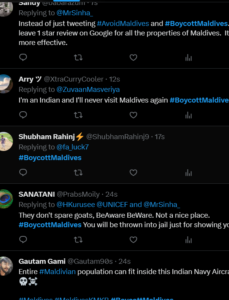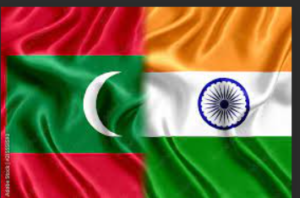The recent rise of the “Boycott Maldives” hashtag on various social media platforms has triggered a wave of discussions and conjectures about the underlying causes and potential ramifications. This trending topic has been associated with a video that documents Prime Minister Narendra Modi’s visit to the Lakshadweep islands on the 2nd and 3rd of January 2024, prompting inquiries about its possible influence on India’s foreign policy approach.

The video that captures Prime Minister Modi’s journey to the Lakshadweep islands has attracted considerable attention due to its symbolic importance. The Prime Minister’s visit to this strategically positioned archipelago sends a strong message about India’s intent to assert its dominance in the region. As a significant factor in the geopolitics of the Indian Ocean, India’s interaction with the Lakshadweep islands carries far-reaching implications for its foreign policy goals.
India’s Strategic Moves Amid ‘Boycott Maldives’

The emergence of the “Boycott Maldives” hashtag coincides with India’s strategic moves in the Indian Ocean region. Amid escalating geopolitical rivalry and concerns about maritime security, India’s foreign policy strategy has increasingly concentrated on strengthening its presence in crucial maritime territories. The Lakshadweep islands, located strategically in the Indian Ocean, are critical to India’s efforts to protect its maritime interests and counter external influences.
The “Boycott Maldives” hashtag also mirrors the changing dynamics in the Indian Ocean region, especially concerning India’s ties with the Maldives. As a key regional player, the Maldives carries substantial geopolitical significance for India’s strategic interests. The hashtag could be a reflection of India’s reaction to perceived challenges or changes in the regional power equilibrium, indicating a sophisticated approach to preserving its influence.
India-Maldives Bilateral Relations
The “Boycott Maldives” social media campaign, in the era of digital connectivity, reflects the evolving geopolitics and public diplomacy. This digital outcry, led by Maldives’ ex-President Abdulla Yameen, is a response to perceived threats to Maldivian sovereignty due to India’s growing influence, especially its strategic moves in Lakshadweep. The campaign underscores the intricate relationship between public sentiment, diplomatic ties, and strategic considerations. It has led to a shift in public discourse and sentiment, potentially affecting public perceptions of the Maldives and influencing policy decisions.

The “India Out” movement in the Maldives, spearheaded by ex-President Abdulla Yameen, is a reaction to India’s expanding role, especially regarding the Uthuru Thila Falhu harbor agreement. Detractors see this as a risk to Maldivian independence. This movement mirrors the shifting dynamics in the Indian Ocean region and India’s strategic actions, such as its efforts to bolster its presence in key maritime areas like Lakshadweep. This dispute has profound effects on the relationship between India and the Maldives, and the balance of power in the region.
Navigating Geopolitical Challenges: A Delicate Balance

In the face of intensifying geopolitical dynamics in the Indian Ocean region, India is tasked with the delicate challenge of navigating intricate issues while protecting its strategic interests. The “Boycott Maldives” hashtag serves as a reminder of the multifaceted factors that shape India’s
foreign policy decisions, necessitating a careful balance of diplomatic engagement, strategic positioning, and public involvement. India’s reaction to this trending campaign will reflect its nuanced approach to managing regional dynamics. This incident underscores the importance of social media in shaping public opinion and influencing policy decisions in today’s interconnected world. It also highlights the need for a balanced and nuanced approach to managing complex geopolitical challenges. 
The emergence of the “Boycott Maldives” hashtag within the context of PM Modi’s Lakshadweep video underscores the interconnectedness of social media trends with broader geopolitical strategies. As India continues to navigate complex regional dynamics, the evolving narrative surrounding this hashtag serves as a testament to the intricate interplay between public discourse, diplomatic maneuvering, and strategic imperatives. The trending campaign highlights the evolving landscape of digital diplomacy and its impact on shaping international relations in the contemporary era.












Comments 3